湖北省沙市中学2015-2016学年高一下学期第一次半月考++英语试题
2015~2016学年度高一下学期英语试卷(附答案)
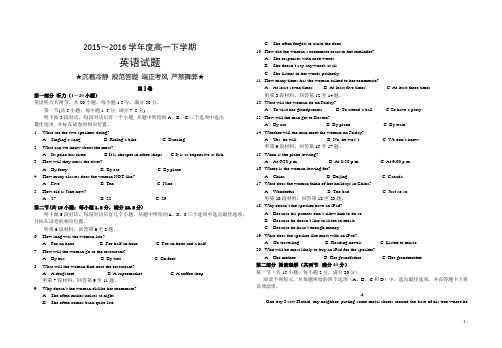
2015~2016学年度高一下学期英语试题★沉着冷静规范答题端正考风严禁舞弊★第Ⅰ卷第一部分听力(1—20小题)英语听力共两节,共20小题,每小题1.5分,满分30分。
第一节(共5小题;每小题1. 5分, 满分7. 5分)听下面5段对话。
每段对话后有一个小题, 从题中所给的A、B、C三个选项中选出最佳选项, 并标在试卷的相应位置。
1.What are the two speakers doing?A.Singing a song.B. Riding a bike.C. Dancing.2.What can we know about the meat?A.Its price has risen.B.It is cheaper in other shops.C.It is as expensive as fish.3.How will they cross the river?A.By ferry.B. By car.C. By plane.4.How many classes does the woman NOT like?A.Five.B. Ten.C. Nine5.How old is Jane now?A.27B. 22C. 29第二节(共15小题:每小题1.5分,满分22.5分)听下面5段对话。
每段对话后有几个小题,从题中所给的A、B、C三个选项中选出最佳选项,并标在试卷的相应位置。
听第6段材料,回答第6至8题。
6.How long was the woman late?A.For an hour.B. For half an hour.C. For an hour and a half.7.How will the woman go to the restaurant?A.By bus.B. By taxi.C. On foot.8.What will the woman find near the restaurant?A. A drugstore.B. A supermarket.C. A coffee shop.听第7段材料,回答第9至11题。
高中英语真题:2015-2016学年高一下学期第一次调研考试试题.doc
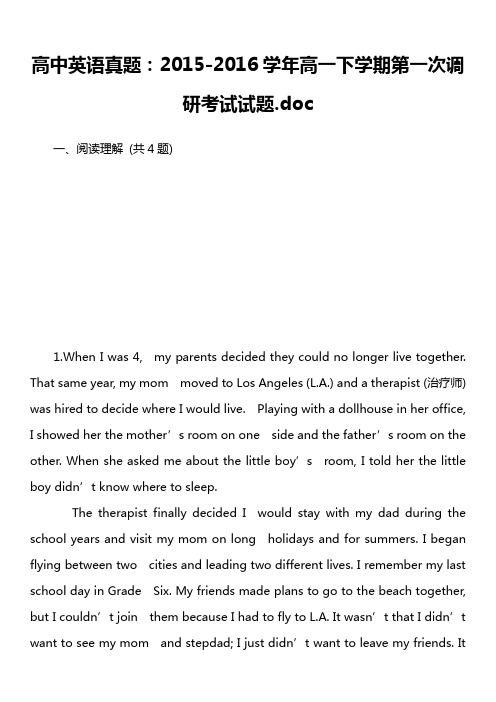
Children at school need this type of memory on a daily basis for a variety of tasks, such as following teachers’ instructions or remembering dictated (听写的) sentences. During the study, volunteers were asked to perform one simple task during which researchers kept asking if their minds were wandering. At the end, volunteers measured their working memory capacity (容量) by their ability to remember a series of letters mixed with simple maths questions.
高中英语
一、阅读理解 (共4题)
1.When I was 4, my parents decided they could no longer live together. That same year, my mom moved to Los Angeles (L.A.) and a therapist (治疗师) was hired to decide where I would live. Playing with a dollhouse in her office, I showed her the mother’s room on one side and the father’s room on the other. When she asked me about the little boy’s room, I told her the little boy didn’t know where to sleep.
湖北省沙市中学2016-2017学年高一下学期第一次双周考英语试题含答案
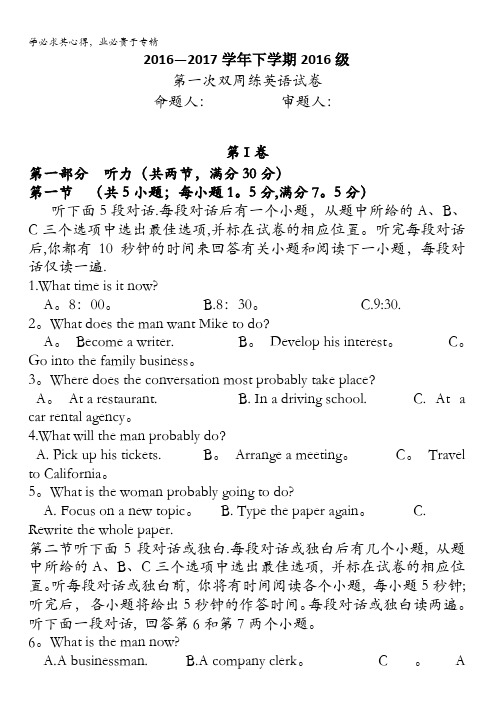
2016—2017学年下学期2016级第一次双周练英语试卷命题人:审题人:第I卷第一部分听力(共两节,满分30分)第一节(共5小题;每小题1。
5分,满分7。
5分)听下面5段对话.每段对话后有一个小题,从题中所给的A、B、C三个选项中选出最佳选项,并标在试卷的相应位置。
听完每段对话后,你都有10秒钟的时间来回答有关小题和阅读下一小题,每段对话仅读一遍.1.What time is it now?A。
8:00。
B.8:30。
C.9:30.2。
What does the man want Mike to do?A。
Become a writer. B。
Develop his interest。
C。
Go into the family business。
3。
Where does the conversation most probably take place?A。
At a restaurant. B. In a driving school. C. At a car rental agency。
4.What will the man probably do?A. Pick up his tickets. B。
Arrange a meeting。
C。
Travel to California。
5。
What is the woman probably going to do?A. Focus on a new topic。
B. Type the paper again。
C. Rewrite the whole paper.第二节听下面5段对话或独白.每段对话或独白后有几个小题, 从题中所给的A、B、C三个选项中选出最佳选项, 并标在试卷的相应位置。
听每段对话或独白前, 你将有时间阅读各个小题, 每小题5秒钟;听完后,各小题将给出5秒钟的作答时间。
每段对话或独白读两遍。
听下面一段对话, 回答第6和第7两个小题。
2015届高一下学期英语半期考试试卷
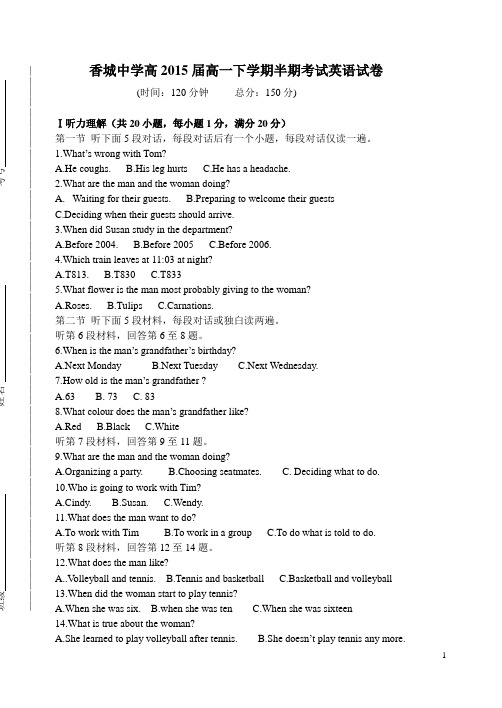
(时间:120分钟总分:150分)Ⅰ听力理解(共20小题,每小题1分,满分20分)第一节听下面5段对话,每段对话后有一个小题,每段对话仅读一遍。
1.What’s wrong with Tom?A.He coughs.B.His leg hurtsC.He has a headache.2.What are the man and the woman doing?A.Waiting for their guests.B.Preparing to welcome their guestsC.Deciding when their guests should arrive.3.When did Susan study in the department?A.Before 2004.B.Before 2005C.Before 2006.4.Which train leaves at 11:03 at night?A.T813.B.T830C.T8335.What flower is the man most probably giving to the woman?A.Roses.B.TulipsC.Carnations.第二节听下面5段材料,每段对话或独白读两遍。
听第6段材料,回答第6至8题。
6.When is the man’s grandfather’s birthday?A.Next MondayB.Next TuesdayC.Next Wednesday.7.How old is the man’s grandfather ?A.63B. 73C. 838.What colour does the man’s grandfather like?A.RedB.BlackC.White听第7段材料,回答第9至11题。
9.What are the man and the woman doing?anizing a party.B.Choosing seatmates.C. Deciding what to do.10.Who is going to work with Tim?A.Cindy.B.Susan.C.Wendy.11.What does the man want to do?A.To work with TimB.To work in a groupC.To do what is told to do.听第8段材料,回答第12至14题。
湖北省沙市2015-2016学年高一英语下册第二次半月考试题

2015—2016学年下学期高一年级第二次半月考英语试卷本试题分第I卷(选择题)和第II卷(非选择题)两部分。
考试结束后,只交答题纸和答题卡,试题自己保留。
第I卷(三部分,共90分)第一部分听力(共两节,满分30分)做题时,现将答案标在试卷上。
录音内容节束后,你将有两分钟的时间将试卷上的答案转涂到答题卡上。
第一节(共5小题;每小题1.5分,满分7.5分)听下面5段对话。
每段对话后有一个小题,从题中所给的A、B、C三个选项中选出最佳选项,并标在试卷的相应位置。
听完每段对话后,你都有10秒钟的时间来回答有关小题和阅读下一小题。
每段对话仅读一遍。
1. How much did Sue pay for the shirt?A. £30.B. £35.C. £40.2. What will the woman give the man?A. A pen.B. A stamp.C. A postcard.3. Where did Sally go this afternoon?A. To a library.B. To a supermarket.C. To a bike shop.4. What does the man want to buy?A. A camera.B. A computer.C. A phone.5. What will the woman buy?A. Bananas.B. Apples.C. Pears.第二节听下面5段对话或独白。
每段对话或独白后有几个小题,从题中所给的A、B、C三个选项中选出最佳选项,并标在试卷的相应位置。
听每段对话或独白前,你将有时间阅读各个小题,每小题5秒钟;听完后,各小题给出5秒钟的作答时间。
每段对话或独白读两遍。
听第6段材料,回答第6、7题。
6. What is the probable relationship between the speakers?A. Husband and wife.B. Customer and saleswoman.C. Boss and secretary.7. What will the man do in Bordeaux?A. Stay with his friends.B. Buy a castle.C. Plant grapes.听第7段材料,回答第8、9题。
中学15—16学年下学期高一第一次月考英语试题(附答案) (1)

2015级高一第二学期第一次考试英语试题第一部分阅读理解(共15小题;每小题2分,满分30分)AIn our daily life, it is necessary to make small talk in certain situations. It helps to fill time between people when it is completely quiet. You may not feel like talking with someone else or you are very shy at the beginning, but it is sometimes thought to be rude to say nothing.People use small talk almost every day. It usually takes place when you meet someone you don’t know at all or someone you’re not familiar with. For example, waitresses and hair dressers often make small talk with their customers. If you happen to be outside when the mailman comes to your door, you might make small talk with him, too.Most often, small talk happens in places where people are waiting for something. For example, you might talk with another person who is waiting for the bus to arrive. People also make small talk in a doctor’s waiting room, or when they are waiting in a line to buy something. At the office, people make small talk in elevators or lunchrooms, especially if there is a line-up. Mingling(交际)is often required among people who don’t know each other very well at a party. In other words, they are expected to walk around and talk with others.The most common time for small talk to happen is the first time you see or meet someone on a given day. For example, if you see a co-worker in the lounge (休息室) you might say hello and discuss the sports or weather. However, the next time you see each other you might just smile and say nothing. If there is very little noise, it might be the right time to start a pleasant conversation. If someone is reading a book at the bus stop, it is probably not a good idea to start a conversation. Another good time to make small talk is during a break in a meeting when there is nothing important going on. However, it is important to recognize the signal when the other person wants the conversation to stop.1. Small talk happens most probably except when _____.A. you’re having your hair cutB. you’re having a meetingC. you’re waiting for a busD. you’re waiting in a line to buy something2. It is the right time to make small talk whenA. there is nothing important going on during a break in a meetingB. the other person doesn’t want to start a conversationC. On the same day, you see a co-worker in the lounge againD. someone is reading a book at the bus stop3. The author develops the last paragraph mainly by _____.A. giving explanationsB. discussing questionsC. telling storiesD. providing examples4. We can learn from the text that small talk _____.A. won’t happen among strangersB. can help to break the silenceC. is often thought to be unnecessaryD. always makes people uncomfortableBHow many coins have you got in your pocket right now? Three? Two?or one?With a phonecard you can make up to 200 calls without any change at all.(1)What do you do with it?Go to a telephone box marked(you guessed it)“phonecard”. Put in your card, make your call and when you’ve finished, a sc reen tells you how much is left on your card.(2)Now appear in a shop near you.Near each Cardphone place you’ll find a shop where you can buy one. They’re at bus, train and city tube stations(地铁).Many universities, hospitals and clubs. Restaurants and gas stations on the highway and shopping centers. At airports and seaports.(3)No more broken payphones.Most broken payphones are like that because they’ve been vandalized(故意破坏). There are no coins in Cardphone to excite thieves’ interest in it. So you’re n ot probably to find a vandalized one.Get a phonecard yourself and try it out ,or get a bigger wallet.5.The passage is most probably ________ .A. a warningB. a noteC. an announcementD. an advertisement(广告)6.There are three sections(部分)in the passage. Which section do you think is about why phonecards are good?A. Section 1.B. Section 2.C..None.D. Section 37.Choose the right order or the steps under “How do you use a phonecard”.a. Put in your phonecard.b. Look at the screen to find out how many calls you can still make.c. Go to a telephone box marked “Phonecard”.d. Make your call.A. a, b, c, dB. a, d, c, bC. c, a, d, bD. c, d, a, bCCode Offence PointsWhat is Driving Offence Points System?After the introduction of this system, certain traffic offences will make the driver lose points besides other punishments (惩罚). A driver makes any of these offences, the points will be recorded.When the driver gets a certain number of points, he will be forbidden (禁止) to drive for a certain amount of time.what are the purposes of this system?This is a system designed to make road much safer. It can improve standards (水平) of driving and reduce accidents.Which traffic offences will result in Driving Offence Points?Of course, not all traffic offences are covered by this system. Only those that have direct effect on road safety are included.There are fourteen items in all.1 Causing death by dangerous driving 102 Dangerous driving 103 Careless driving 54 Driving after drinking or taking drugs 105 Driving over speed limit by more than15 km/hour 36 Driving in a motor race on the road 107 Failing to stop after an accident 38 Failing to give information after an accident 39 Failing to report an accident 310 Failing to obey directions of police officers 311 Crossing double white lines 312 Failing to obey traffic signals 313 Failing to give way to walkers at a crosswalk. Failing to stop for people walking 314 Failing to stop at school crossing 3What will happen if you have got up to 10 points?If you have got 10 points or above, but still less than 15 points, you will receive a warning letter from the Transport Department. This letter will tell your record of Driving Offence Points and remind you of the result of getting more points. It is hoped that this warning will change your driving behavior for the better.What will happen if you have got 15 points?If you have got 15 points or more within two years, a court will take away your driving license. The first time you are found guilty you will not be able to drive for three months, but if you are caught a second time you will not be able to drive for six months.8. The underlined word “Offence” (Paragraph 1 ) refers to ______.A. a driving habitB. an action against the traffic lawC. bad behavior in the officeD. an official of road safety9. The Driving Offence Points _________.A. are points earned because of dangerous drivingB. is a system that helps to improve the driving standardsC. shows traffic offences of different kindsD. is a guide dealing with traffic offences10. What will happen to you if you have got 13 points?A. You will be punished for the points.B. Your driving license will be taken away.C. You will get a warning letter from the Transport Department.D. Your record will be sent to the Transport Department.11. What will happen to you if you are caught driving dangerously and two months later you arecaught careless driving?A. Your license will be taken away.B. You will be taken to the police station.C. You will not be able to drive for 6 months.D. You will not be able to drive for 3 months.D.As each semester begins, my colleague greets his students wearing a jacket and tie.“You make only one first impression,” he says. So while the rest of the semester he teaches class in his usual, more casual clothes, the first week he presents a different image.His thought is that students will remember their first meet positively and more readily think highly of him as the semester goes on because that favorable first impression has an influence on them.The sequence (顺序) that we meet matters in how we judge subsequent (后来的) information. The big influence of first impressions is related to the halo effect, where the perception (看法) of positive qualities in one thing or part gives rise to the perception of similar qualities in related things or in the whole.Here is an example: You meet a friendly person at a party and later are asked to collect money for a worthy cause. You call that person because you think she will make a contribution. In reality, there is no connection between being pleasant and being generous. Yet the halo effect leads you to think that the two are related.The halo effect is powerful, but it is questionable whether it matters much in long-term relationships, such as that between teacher and student. While dressing up may make students think the teacher must know his subject matter because he creates a professional first impression, the effect wears thin if the person turns out to be a poor teacher after all.First impressions matter but they don’t have the final word. Facts speak louder. If you had never seen or heard of Einstein, the first time you saw him your impression would most likely be negative. Now his face is connected with genius (天才), not madness because he is the person who has come to define what genius is.The problem is that few of us are Einsteins and we often don’t get the chance to change a negative first impression.12. The author explains the halo effect mainly by _____.A. following the order of importanceB. making a comparisonC. setting down general rulesD. giving an example13. In the author’s eyes, the halo effect _____.A. is surprisingly powerfulB. matters more in the long runC. makes some teachers irresponsibleD. may affect our judgment of others14. The author uses the example of Einstein to show the importance of _____.A. appearanceB. impressionsC. truthD. fairness15. The author seems to advise readers _____.A. not to follow others’ judgmentsB. not to judge a book by its coverC. to mind their first impressionsD. to pay no attention to the halo effect第二节:阅读填句(共5小题;每小题2分,满分10分)根据短文内容,从短文后的选项中选出能填入空白处的最佳选项,选项中有两项为多余选项。
湖北省沙市中学2015-2016学年高一英语下学期第三次半月考试题
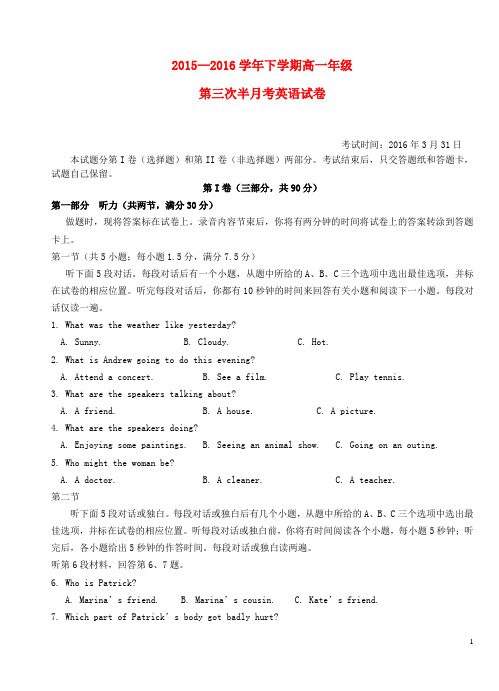
2015—2016学年下学期高一年级第三次半月考英语试卷考试时间:2016年3月31日本试题分第I卷(选择题)和第II卷(非选择题)两部分。
考试结束后,只交答题纸和答题卡,试题自己保留。
第I卷(三部分,共90分)第一部分听力(共两节,满分30分)做题时,现将答案标在试卷上。
录音内容节束后,你将有两分钟的时间将试卷上的答案转涂到答题卡上。
第一节(共5小题;每小题1.5分,满分7.5分)听下面5段对话。
每段对话后有一个小题,从题中所给的A、B、C三个选项中选出最佳选项,并标在试卷的相应位置。
听完每段对话后,你都有10秒钟的时间来回答有关小题和阅读下一小题。
每段对话仅读一遍。
1. What was the weather like yesterday?A. Sunny.B. Cloudy.C. Hot.2. What is Andrew going to do this evening?A. Attend a concert.B. See a film.C. Play tennis.3. What are the speakers talking about?A. A friend.B. A house.C. A picture.4. What are the speakers doing?A. Enjoying some paintings.B. Seeing an animal show.C. Going on an outing.5. Who might the woman be?A. A doctor.B. A cleaner.C. A teacher.第二节听下面5段对话或独白。
每段对话或独白后有几个小题,从题中所给的A、B、C三个选项中选出最佳选项,并标在试卷的相应位置。
听每段对话或独白前,你将有时间阅读各个小题,每小题5秒钟;听完后,各小题给出5秒钟的作答时间。
每段对话或独白读两遍。
听第6段材料,回答第6、7题。
【英语】湖北省荆州中学2015-2016学年高一下学期第一次(3月)阶段性考试
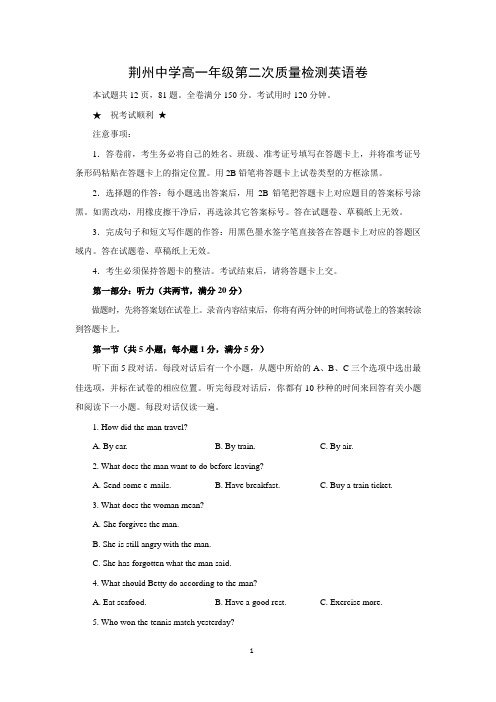
荆州中学高一年级第二次质量检测英语卷本试题共12页,81题。
全卷满分150分。
考试用时120分钟。
★祝考试顺利★注意事项:1.答卷前,考生务必将自己的姓名、班级、准考证号填写在答题卡上,并将准考证号条形码粘贴在答题卡上的指定位置。
用2B铅笔将答题卡上试卷类型的方框涂黑。
2.选择题的作答:每小题选出答案后,用2B铅笔把答题卡上对应题目的答案标号涂黑。
如需改动,用橡皮擦干净后,再选涂其它答案标号。
答在试题卷、草稿纸上无效。
3.完成句子和短文写作题的作答:用黑色墨水签字笔直接答在答题卡上对应的答题区域内。
答在试题卷、草稿纸上无效。
4.考生必须保持答题卡的整洁。
考试结束后,请将答题卡上交。
第一部分:听力(共两节,满分20分)做题时,先将答案划在试卷上。
录音内容结束后,你将有两分钟的时间将试卷上的答案转涂到答题卡上。
第一节(共5小题;每小题1分,满分5分)听下面5段对话。
每段对话后有一个小题,从题中所给的A、B、C三个选项中选出最佳选项,并标在试卷的相应位置。
听完每段对话后,你都有10秒种的时间来回答有关小题和阅读下一小题。
每段对话仅读一遍。
1. How did the man travel?A. By car.B. By train.C. By air.2. What does the man want to do before leaving?A. Send some e-mails.B. Have breakfast.C. Buy a train ticket.3. What does the woman mean?A. She forgives the man.B. She is still angry with the man.C. She has forgotten what the man said.4. What should Betty do according to the man?A. Eat seafood.B. Have a good rest.C. Exercise more.5. Who won the tennis match yesterday?A. Mark.B. Sally’s brother.C. Sally.第二节(共l5小题;每小题1分,满分15分)听下面5段对话或独白。
高一英语月考试题及答案-沙市中学-学年高一下学期第一次周练1
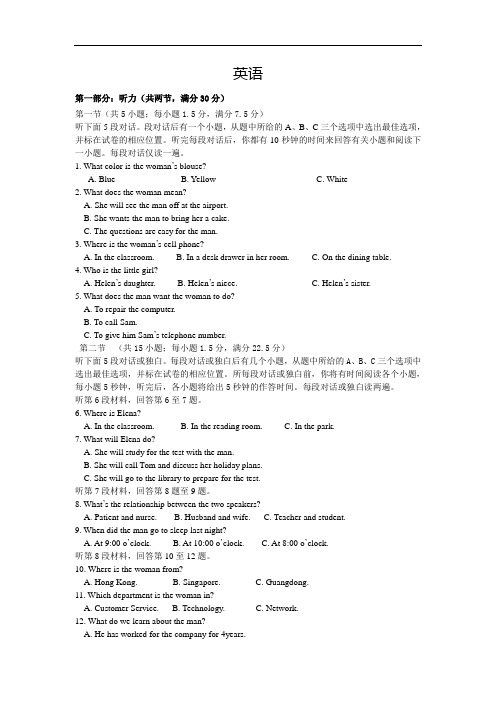
英语第一部分:听力(共两节,满分30分)第一节(共5小题;每小题1.5分,满分7.5分)听下面5段对话。
段对话后有一个小题,从题中所给的A、B、C三个选项中选出最佳选项,并标在试卷的相应位置。
听完每段对话后,你都有10秒钟的时间来回答有关小题和阅读下一小题。
每段对话仅读一遍。
1. What color is the woman’s blouse?A. BlueB. YellowC. White2. What does the woman mean?A. She will see the man off at the airport.B. She wants the man to bring her a cake.C. The questions are easy for the man.3. Where is the woman’s cell phone?A. In the classroom.B. In a desk drawer in her room.C. On the dining table.4. Who is the little girl?A. Helen’s daughter.B. Helen’s niece.C. Helen’s sister.5. What does the man want the woman to do?A. To repair the computer.B. To call Sam.C. To give him Sam’s telephone number.第二节(共15小题;每小题1.5分,满分22.5分)听下面5段对话或独白。
每段对话或独白后有几个小题,从题中所给的A、B、C三个选项中选出最佳选项,并标在试卷的相应位置。
所每段对话或独白前,你将有时间阅读各个小题,每小题5秒钟,听完后,各小题将给出5秒钟的作答时间。
每段对话或独白读两遍。
听第6段材料,回答第6至7题。
湖北省沙市中学2016届高三下学期第一次半月考英语试题及答案
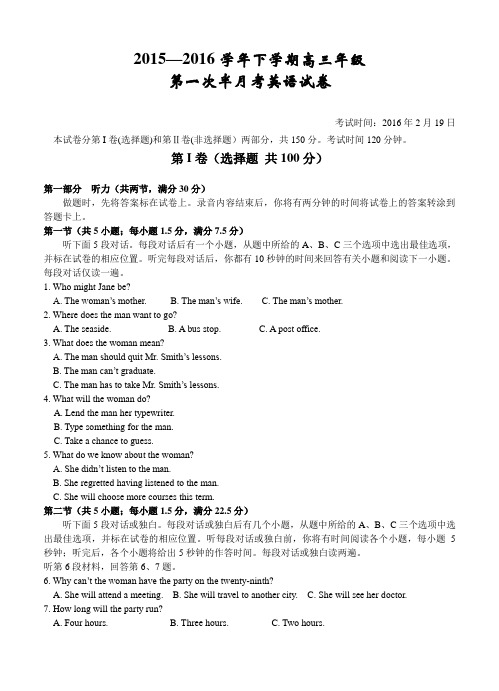
2015—2016学年下学期高三年级第一次半月考英语试卷考试时间:2016年2月19日本试卷分第I卷(选择题)和第Ⅱ卷(非选择题)两部分,共150分。
考试时间120分钟。
第I卷(选择题共100分)第一部分听力(共两节,满分30分)做题时,先将答案标在试卷上。
录音内容结束后,你将有两分钟的时间将试卷上的答案转涂到答题卡上。
第一节(共5小题;每小题1.5分,满分7.5分)听下面5段对话。
每段对话后有一个小题,从题中所给的A、B、C三个选项中选出最佳选项,并标在试卷的相应位置。
听完每段对话后,你都有10秒钟的时间来回答有关小题和阅读下一小题。
每段对话仅读一遍。
1. Who might Jane be?A. The woman’s mother.B. The man’s wife.C. The man’s mother.2. Where does the man want to go?A. The seaside.B. A bus stop.C. A post office.3. What does the woman mean?A. The man should quit Mr. Smith’s lessons.B. The man can’t graduate.C. The man has to take Mr. Smith’s lessons.4. What will the woman do?A. Lend the man her typewriter.B. Type something for the man.C. Take a chance to guess.5. What do we know about the woman?A. She didn’t listen to the man.B. She regretted having listened to the man.C. She will choose more courses this term.第二节(共5小题;每小题1.5分,满分22.5分)听下面5段对话或独白。
湖北省沙市中学2015-2016学年高一下学期第一次半月考
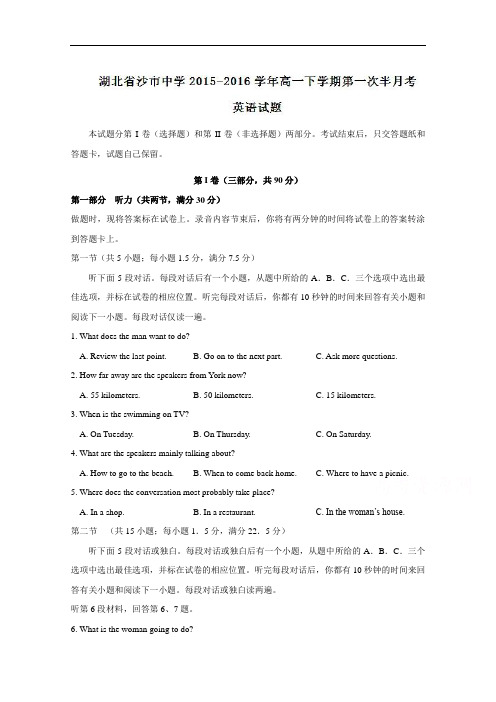
本试题分第I卷(选择题)和第II卷(非选择题)两部分。
考试结束后,只交答题纸和答题卡,试题自己保留。
第I卷(三部分,共90分)第一部分听力(共两节,满分30分)做题时,现将答案标在试卷上。
录音内容节束后,你将有两分钟的时间将试卷上的答案转涂到答题卡上。
第一节(共5小题;每小题1.5分,满分7.5分)听下面5段对话。
每段对话后有一个小题,从题中所给的A.B.C.三个选项中选出最佳选项,并标在试卷的相应位置。
听完每段对话后,你都有10秒钟的时间来回答有关小题和阅读下一小题。
每段对话仅读一遍。
1. What does the man want to do?A. Review the last point.B. Go on to the next part.C. Ask more questions.2. How far away are the speakers from York now?A. 55 kilometers.B. 50 kilometers.C. 15 kilometers.3. When is the swimming on TV?A. On Tuesday.B. On Thursday.C. On Saturday.4. What are the speakers mainly talking about?A. How to go to the beach.B. When to come back home.C. Where to have a picnic.5. Where does the conversation most probably take place?A. In a shop.B. In a restaurant.C. In the woman’s house.第二节(共15小题;每小题1.5分,满分22.5分)听下面5段对话或独白。
每段对话或独白后有一个小题,从题中所给的A.B.C.三个选项中选出最佳选项,并标在试卷的相应位置。
湖北省沙市中学高三1月月考英语试题
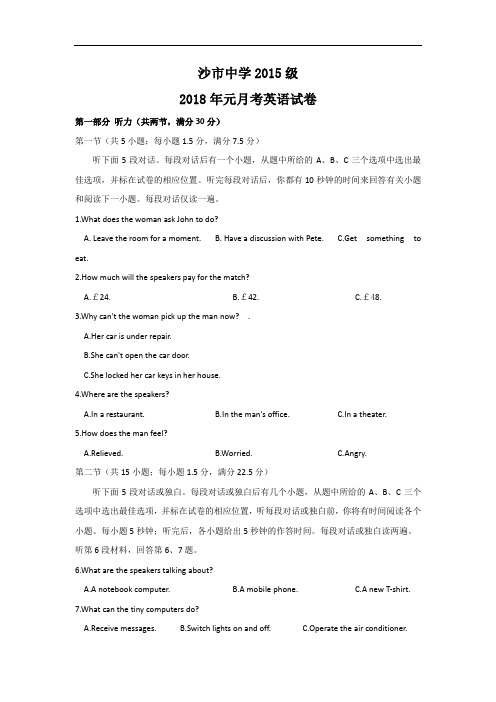
沙市中学2015级2018年元月考英语试卷第一部分听力(共两节,满分30分)第一节(共5小题;每小题1.5分,满分7.5分)听下面5段对话。
每段对话后有一个小题,从题中所给的A、B、C三个选项中选出最佳选项,并标在试卷的相应位置。
听完每段对话后,你都有10秒钟的时间来回答有关小题和阅读下一小题。
每段对话仅读一遍。
1.What does the woman ask John to do?A. Leave the room for a moment.B. Have a discussion with Pete.C.Get something to eat.2.How much will the speakers pay for the match?A.£24.B.£42.C.£48.3.Why can't the woman pick up the man now? .A.Her car is under repair.B.She can't open the car door.C.She locked her car keys in her house.4.Where are the speakers?A.In a restaurant.B.In the man's office.C.In a theater.5.How does the man feel?A.Relieved.B.Worried.C.Angry.第二节(共15小题;每小题1.5分,满分22.5分)听下面5段对话或独白。
每段对话或独白后有几个小题,从题中所给的A、B、C三个选项中选出最佳选项,并标在试卷的相应位置,听每段对话或独白前,你将有时间阅读各个小题。
每小题5秒钟;听完后,各小题给出5秒钟的作答时间。
每段对话或独白读两遍。
听第6段材料,回答第6、7题。
6.What are the speakers talking about?A.A notebook computer.B.A mobile phone.C.A new T-shirt.7.What can the tiny computers do?A.Receive messages.B.Switch lights on and off.C.Operate the air conditioner.听第7段材料,回答第8、9题。
湖北省沙市中学高一英语下学期第一次周练试题新人教版
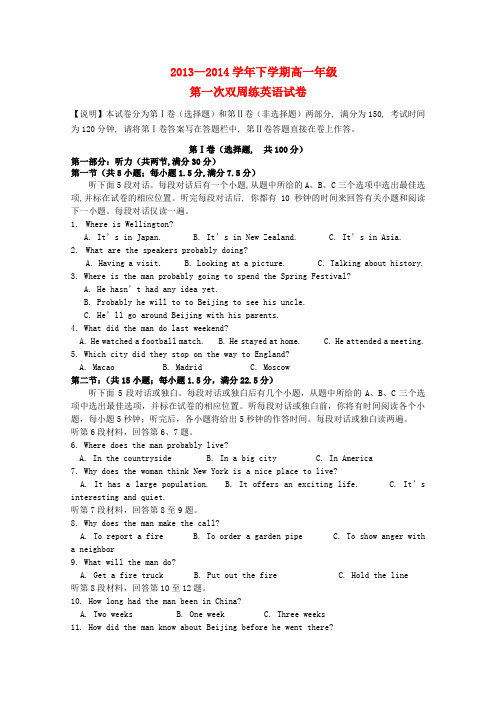
2013—2014学年下学期高一年级第一次双周练英语试卷【说明】本试卷分为第Ⅰ卷(选择题)和第Ⅱ卷(非选择题)两部分, 满分为150, 考试时间为120分钟, 请将第Ⅰ卷答案写在答题栏中, 第Ⅱ卷答题直接在卷上作答。
第Ⅰ卷(选择题, 共100分)第一部分:听力(共两节,满分30分)第一节(共5小题;每小题1.5分,满分7.5分)听下面5段对话。
每段对话后有一个小题,从题中所给的A、B、C三个选项中选出最佳选项,并标在试卷的相应位置。
听完每段对话后, 你都有10秒钟的时间来回答有关小题和阅读下一小题。
每段对话仅读一遍。
1.Where is Wellington?A. It’s in Japan.B. It’s in New Zealand.C. It’s in Asia.2.What are the speakers probably doing?A. Having a visit.B. Looking at a picture.C. Talking about history.3. Where is the man probably going to spend the Spring Festival?A. He hasn’t had any idea yet.B. Probably he will to to Beijing to see his uncle.C. He’ll go around Beijing with his parents.4. What did the man do last weekend?A. He watched a football match.B. He stayed at home.C. He attended a meeting.5. Which city did they stop on the way to England?A. MacaoB. MadridC. Moscow第二节:(共15小题;每小题1.5分,满分22.5分)听下面5段对话或独白。
湖北省沙市中学高一英语下学期第二次半月考试题(无答
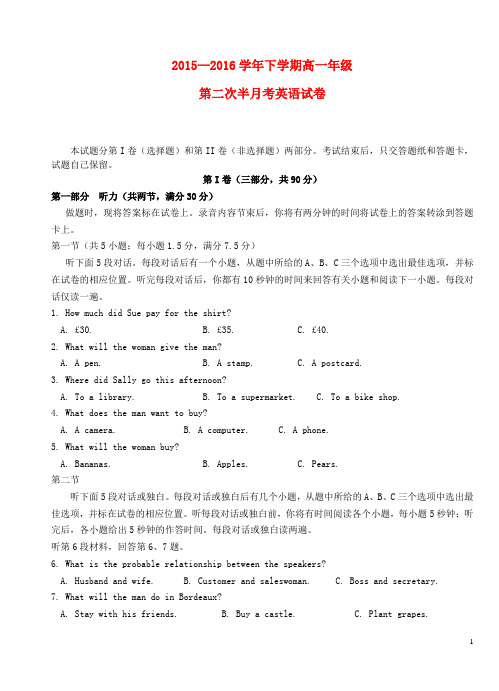
2015—2016学年下学期高一年级第二次半月考英语试卷本试题分第I卷(选择题)和第II卷(非选择题)两部分。
考试结束后,只交答题纸和答题卡,试题自己保留。
第I卷(三部分,共90分)第一部分听力(共两节,满分30分)做题时,现将答案标在试卷上。
录音内容节束后,你将有两分钟的时间将试卷上的答案转涂到答题卡上。
第一节(共5小题;每小题1.5分,满分7.5分)听下面5段对话。
每段对话后有一个小题,从题中所给的A、B、C三个选项中选出最佳选项,并标在试卷的相应位置。
听完每段对话后,你都有10秒钟的时间来回答有关小题和阅读下一小题。
每段对话仅读一遍。
1. How much did Sue pay for the shirt?A. £30.B. £35.C. £40.2. What will the woman give the man?A. A pen.B. A stamp.C. A postcard.3. Where did Sally go this afternoon?A. To a library.B. To a supermarket.C. To a bike shop.4. What does the man want to buy?A. A camera.B. A computer.C. A phone.5. What will the woman buy?A. Bananas.B. Apples.C. Pears.第二节听下面5段对话或独白。
每段对话或独白后有几个小题,从题中所给的A、B、C三个选项中选出最佳选项,并标在试卷的相应位置。
听每段对话或独白前,你将有时间阅读各个小题,每小题5秒钟;听完后,各小题给出5秒钟的作答时间。
每段对话或独白读两遍。
听第6段材料,回答第6、7题。
6. What is the probable relationship between the speakers?A. Husband and wife.B. Customer and saleswoman.C. Boss and secretary.7. What will the man do in Bordeaux?A. Stay with his friends.B. Buy a castle.C. Plant grapes.听第7段材料,回答第8、9题。
湖北省沙市高一英语下学期第一次周练试题
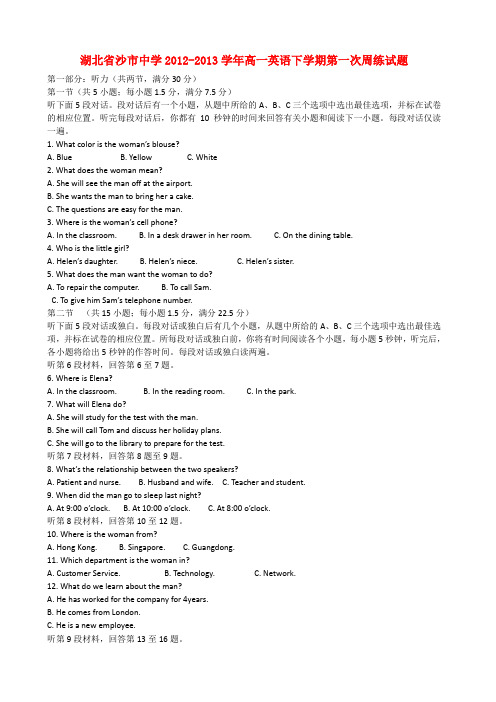
湖北省沙市中学2012-2013学年高一英语下学期第一次周练试题第一部分:听力(共两节,满分30分)第一节(共5小题;每小题1.5分,满分7.5分)听下面5段对话。
段对话后有一个小题,从题中所给的A、B、C三个选项中选出最佳选项,并标在试卷的相应位置。
听完每段对话后,你都有10秒钟的时间来回答有关小题和阅读下一小题。
每段对话仅读一遍。
1. What color is the woman’s blouse?A. BlueB. YellowC. White2. What does the woman mean?A. She will see the man off at the airport.B. She wants the man to bring her a cake.C. The questions are easy for the man.3. Where is the woman’s cell phone?A. In the classroom.B. In a desk drawer in her room.C. On the dining table.4. Who is the little girl?A. Helen’s daughter.B. Helen’s niece.C. Helen’s sister.5. What does the man want the woman to do?A. To repair the computer.B. To call Sam.C. To give him Sam’s telephone number.第二节(共15小题;每小题1.5分,满分22.5分)听下面5段对话或独白。
每段对话或独白后有几个小题,从题中所给的A、B、C三个选项中选出最佳选项,并标在试卷的相应位置。
所每段对话或独白前,你将有时间阅读各个小题,每小题5秒钟,听完后,各小题将给出5秒钟的作答时间。
湖北省荆州中学高一英语下学期第一次(3月)阶段性考试试题

湖北省荆州中学2015-2016学年高一英语下学期第一次(3月)阶段性考试试题本试题共12页,81题。
全卷满分150分。
考试用时120分钟。
★祝考试顺利★注意事项:1.答卷前,考生务必将自己的姓名、班级、准考证号填写在答题卡上,并将准考证号条形码粘贴在答题卡上的指定位置。
用2B铅笔将答题卡上试卷类型的方框涂黑。
2.选择题的作答:每小题选出答案后,用2B铅笔把答题卡上对应题目的答案标号涂黑。
如需改动,用橡皮擦干净后,再选涂其它答案标号。
答在试题卷、草稿纸上无效。
3.完成句子和短文写作题的作答:用黑色墨水签字笔直接答在答题卡上对应的答题区域内。
答在试题卷、草稿纸上无效。
4.考生必须保持答题卡的整洁。
考试结束后,请将答题卡上交。
第一部分:听力(共两节,满分20分)做题时,先将答案划在试卷上。
录音内容结束后,你将有两分钟的时间将试卷上的答案转涂到答题卡上。
第一节(共5小题;每小题1分,满分5分)听下面5段对话。
每段对话后有一个小题,从题中所给的A、B、C三个选项中选出最佳选项,并标在试卷的相应位置。
听完每段对话后,你都有10秒种的时间来回答有关小题和阅读下一小题。
每段对话仅读一遍。
1. How did the man travel?A. By car.B. By train.C. By air.2. What does the man want to do before leaving?A. Send some e-mails.B. Have breakfast.C. Buy a train ticket.3. What does the woman mean?A. She forgives the man.B. She is still angry with the man.C. She has forgotten what the man said.4. What should Betty do according to the man?A. Eat seafood.B. Have a good rest.C. Exercise more.5. Who won the tennis match yesterday?A. Mark.B. Sally’s brother.C. Sally.第二节(共l5小题;每小题1分,满分15分)听下面5段对话或独白。
湖北省沙市中学、恩施高中、郧阳中学2015-2016学年高一英语5月联考精彩试题(无问题详解)
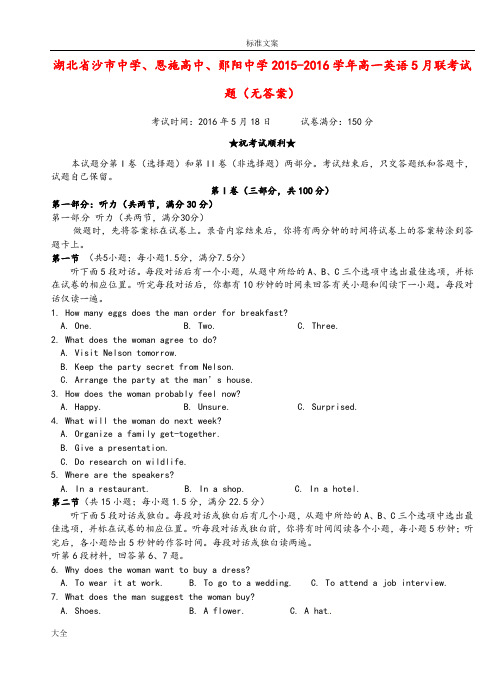
湖北省沙市中学、恩施高中、郧阳中学2015-2016学年高一英语5月联考试题(无答案)考试时间:2016年5月18日试卷满分:150分★祝考试顺利★本试题分第I卷(选择题)和第II卷(非选择题)两部分。
考试结束后,只交答题纸和答题卡,试题自己保留。
第I卷(三部分,共100分)第一部分:听力(共两节,满分30分)第一部分听力(共两节,满分30分)做题时,先将答案标在试卷上。
录音内容结束后,你将有两分钟的时间将试卷上的答案转涂到答题卡上。
第一节(共5小题;每小题1.5分,满分7.5分)听下面5段对话。
每段对话后有一个小题,从题中所给的A、B、C三个选项中选出最佳选项,并标在试卷的相应位置。
听完每段对话后,你都有10秒钟的时间来回答有关小题和阅读下一小题。
每段对话仅读一遍。
1. How many eggs does the man order for breakfast?A. One.B. Two.C. Three.2. What does the woman agree to do?A. Visit Nelson tomorrow.B. Keep the party secret from Nelson.C. Arrange the party at the man’s house.3. How does the woman probably feel now?A. Happy.B. Unsure.C. Surprised.4. What will the woman do next week?A. Organize a family get-together.B. Give a presentation.C. Do research on wildlife.5. Where are the speakers?A. In a restaurant.B. In a shop.C. In a hotel.第二节(共15小题;每小题1.5分,满分22.5分)听下面5段对话或独白。
- 1、下载文档前请自行甄别文档内容的完整性,平台不提供额外的编辑、内容补充、找答案等附加服务。
- 2、"仅部分预览"的文档,不可在线预览部分如存在完整性等问题,可反馈申请退款(可完整预览的文档不适用该条件!)。
- 3、如文档侵犯您的权益,请联系客服反馈,我们会尽快为您处理(人工客服工作时间:9:00-18:30)。
第一次半月考英语试卷考试时间:2016年3月3日本试题分第I卷(选择题)和第II卷(非选择题)两部分。
考试结束后,只交答题纸和答题卡,试题自己保留。
第I卷(三部分,共90分)第一部分听力(共两节,满分30分)做题时,现将答案标在试卷上。
录音内容节束后,你将有两分钟的时间将试卷上的答案转涂到答题卡上。
第一节(共5小题;每小题1.5分,满分7.5分)听下面5段对话。
每段对话后有一个小题,从题中所给的A.B.C.三个选项中选出最佳选项,并标在试卷的相应位置。
听完每段对话后,你都有10秒钟的时间来回答有关小题和阅读下一小题。
每段对话仅读一遍。
1. What does the man want to do?A. Review the last point.B. Go on to the next part.C. Ask more questions.2. How far away are the speakers from York now?A. 55 kilometers.B. 50 kilometers.C. 15 kilometers.3. When is the swimming on TV?A. On Tuesday.B. On Thursday.C. On Saturday.4. What are the speakers mainly talking about?A. How to go to the beach.B. When to come back home.C. Where to have a picnic.5. Where does the conversation most probably take place?A. In a shop.B. In a restaurant.C. In the woman’s house.第二节(共15小题;每小题1.5分,满分22.5分)听下面5段对话或独白。
每段对话或独白后有一个小题,从题中所给的A.B.C.三个选项中选出最佳选项,并标在试卷的相应位置。
听完每段对话后,你都有10秒钟的时间来回答有关小题和阅读下一小题。
每段对话或独白读两遍。
听第6段材料,回答第6、7题。
6. What is the woman going to do?A. Watch TV.B. Have dinner.C. Go shopping.7. Where is the wom an’s phone?A. On the sofa.B. On the table.C. On the TV.听第7段材料,回答第8、9题。
8. Where did the man spend his holiday?A. In the mountains.B. In the city.C. By the sea.9. What did the woman think of her holiday?A. Busy.B. Noisy.C. Boring.听第8段材料,回答第10至12题。
10. Who is taking the boy to the festival?A. His brother.B. His cousin.C. His sister.11. How will the boy go to the festival?A. By car.B. By bus.C. By bicycle.12. What will the boy take with him?A. Clothes.B. Drinks.C. Food.听第9段材料,回答第13至16题。
13. At what time do lessons begin every day at the boy’s school?A. 8:20.B. 8:30.C. 8:50.14. What does the boy like best about the school uniform?A. The coat.B. The trousers.C. The sweater.15. Which subject does the boy enjoy most?A. English.B. Maths.C. History.16. What sport does the boy do at school?A. Tennis.B. Football.C. Swimming.听第10段材料,回答第17至20题。
17. Why did Mr. Baggins get in touch with the City Bike Shop?A. To have a bike repaired.B. To change a bike.C. To buy a bike.18. What does the speaker think Mr. Baggins will be satisfied with about the bike?A. The colour.B. The price.C. The style.19. Where should Mr. Baggins go to pick up the bike?A. To the shop at No. 33 North Street.B. To the shop at No. 87 North Street.C. To the shop next to the supermarket.20. What is Mr. Baggins required to do to get a copy of the bill?A. Visit the shop.B. E-mail the shop.C. Call the shop.第二部分阅读理解(共两节,满分40分)第一节(共15小题,每小题2分,满分30分)阅读下列短文,从每小题所给的四个选项(A.B.C和.D)中,选出最佳选项。
AThe young boy saw me, or rather, he saw the car and quickly ran up to me, eager to sell his bunches (串) of bananas and bags of peanuts. Though he appeared to be about twelve, he seemed to have already known the bitterness of life. "Banana 300 naira. Peanuts 200 naira"He said in a low voice. I bargained him down to 200 total for the fruit and nuts. When he agreed, I handed him a 500 naira bill He didn't have change, so I told him not to worry.He said thanks and smiled a row of perfect teeth.When, two weeks later, I saw the boy again, I was more aware of my position in a society where it's not that uncommon to see a little boy who should be in school standing on the corner selling fruit in the burning sun. My parents had raised me to be aware of the advantage we had been afforded and the responsibility it brought to us.I pulled over and rolled down my window. He had a bunch of bananas and a bag of peanuts ready. I waved them away. “What's up”. I asked him. “I...I don't have money to buy books for school.” I reached into my pocket and handed him two fresh 500 naira bills."Will this help?” I asked. He looked around nervously before taking the money. One thous and naira was a lot of money to someone whose family probably made about 5,000 naira or less each year. "Thank you, sir," he said. 'Thank you very much.”When driving home, I wondered if my little friend actually used the money for school-books. What if he's a cheat? And then I wondered why I did it. Did I do it to make myself feel better? Was I using him? Later, I realized that I didn't know his name or the least bit about him, nor did I think to ask.Over the next six months, I was busy working in a news agency in northern Nigeria. Sometime after I returned, I went out for a drive. When I was about to pull over, the boy suddenly appeared by my window with a big smile ready on his face"oh, gosh! Long time.""Are you in school now?” I asked.He nodded."That's good," I said. A silence fell as we looked at each other, and then I realized what he wanted."Here," I held out a 500 naira bill. "Take this.” He shook his head and stepped back as if hurt. "What's wrong?” I asked. "It's a gift"He shook his head again and brought his hand from behind his back. His face shone with sweat(汗水). He dropped a bunch of bananas and a bag of peanuts in the front seat before he said, "I've been waiting to give these to you."21. What was the author's first impression of the boy?A. He seemed to be poor and mean.B. He seemed to have suffered a lotC. He seemed younger than his age.D. He seemed good at bargaining22. The second time the author met the boy, the boy________.A. told him his purpose of selling fruit and nutsB. wanted to express his thanksC. asked him for money for his schoolbooksD. tried to cheat him by his appearance23. Why did the author give his money to the boy?A. Because he had enough money to do that.B. Because he had learnt to help others since childhood.C. Because he held a higher position in the society.D. Because he had been asked by the news agency to do so.24. Which of the following best describes the boy?A. Brave and polite.B. Kind and smartC. Honest and thankful.D. Shy and nervous.BHow would you like an easy way to earn $2,500? All you have to do is to sit around and wait for your meals. There’s a catch, however. You have to stay in a chicken cage with a stranger for a whole week. There areno books or television or radio for a whole week. There are no books or television or radio for amusement. You can’t leave until the week is up. And a camera will be recording your every move.Two people actually took the job. The idea came from Rob Thompson, a video artist. He wanted to make a film about the way animals are treated. His goal was to raise people’s awareness (认识) of the living conditions of animals that are raised for food. He decided to pay $5,000 out of his own savings to two people who were willing to live like chickens for a week.To Rob’s surprise, quite a few people answered his advertisement. He had inte rviews and selected Eric, a 24-year-old restaurant worker, and Pam, a 27-year-old chemist. The plan was for them to spend seven days together in a chicken cage that was six feet long and three feet wide. A camera would record their experience, which would take place in an art museum.The week was long and difficult. They slept on a hard wooden floor. They couldn’t stand up without banging their heads. They ate mash(a kind of food for animals) and drink water from a garden pipe. Their only privacy (隐私) was a toilet surrounded by a curtain. There were no sinks, mirrors, or toothbrushes in the cage. Visitors who came here were warned, “Do not feed the humans.”Finally it was over, and Pam and Eric came out of the cage. They had survived the week, and they each had a $2,500 check in their hands. When Rob Thompson opened the cage, Eric came out, changed into clean clothes, and ate a chocolate bar right away. “It’s great for me to be able to stand up.” he said. Pam just changed her clothes and left. After a week of visitors and reporters watching her, she didn’t want to talk to anyone.25. The underlined word “catch”(in Paragraph 1) probably means _______.A. unsolved problemB. surprising wonderC. unbelievable conditionD. hidden difficulty26. What made it the most difficult for the two to stay in the cage?A. That they had nothing for fun.B. That they didn’t have meat to eat.C. That they couldn’t lie down to sleep in the cage.D. That they had to do almost everything in public.27. Rob Thompson offered the job in order to___________.A. Make a film about humans and animalsB. Advertise for his experiment about animalsC. Show how terribly some animals are treatedD. Experiment on how long a human can live in a cage28. What would be the best title for this passage?A. An Easy Way to Earn $2,500B. Do Not Treat Animals BadlyC. Living Like a ChickenD. Getting Along Well AnywayCOf all the things that will make life entirely happy, the greatest is the possession of friendship. One loyal friend is worth ten thousand relatives. Friends are very rare jewels, indeed. They make you smile and encourage you to succeed.On the first Sunday in August, it’s time to recognize your friends and their contribution to your lif e. The first Sunday in August was fixed as National Friendship Day by the U.S. Congress in 1935, and remains a tradition in many countries and cultures. In 1997, the United Nations named Winnie the Pooh as the world’s Ambassador of Friendship.Obviously, there are several friendship holidays, all of which fall on fixed dates.National Friendship Day is on the first Sunday in AugustWomen’s Friendship Day is on the third Sunday in SeptemberInternational Friendship Month is FebruaryOld Friends, New Friends Week is the third week of MayPeople show their appreciation for friendship in various ways. Some expressions may be practical ones, such as flowers, particularly the pink friendship roses, cookies, chocolates, souvenirs from their vacations, a tape of favorite songs, farewell dinners, and welcome balloons.Recipe for Friendship 2 cups of patience, 1 heart full of love, 2 handfuls of generosity, 2 cups of loyalty, 1 cup of understanding, with some laughter. Mix them all well. Spray (喷洒) generously over a lifetime and serve everyone you meet.Friendship helps to bring peace and positive things to the globe, another great reason to celebrate! Although our friends certainly deserve thanks on more than just one day of the year, what better day to honor them than Friendship Day!!29. Which of the following proverbs supports the main idea of the first paragraph?A. Friendship cannot stand always on one side.B. A friend in need is a friend indeed.C. A friend without faults will never be found.D. A life without a friend is a life without a sun.30. Which of the holidays happens first in a year?A. National Friendship Day.B. Women’s Friendship Day.C. International Friendship Month.D. Old Friends, New Friends Week.31. What is most needed to make friendship grow, develop and last?A. Inviting your friends over for a party.B. Looking on your friends as relatives.C. Honoring your friends on Friendship Day.D. Being loyal and generous to your friends.32. “Recipe for Friendship” here actually means ______________.A. a prescription (处方) for curing friendsB. a method of keeping a friendshipC. the pleasure of having friendsD. the importance of friendshipDFoxes and farmers have never got on well. These small dog-like animals have long been accused (控告)of killing farm animals. They are officially considered as harmful and farmers try to keep their numbers down by shooting or poisoning them.Farmers can do call on the services of their local hunt to control the fox population . Hunting consists of hunting a fox across the countryside, with a group of specially trained dogs, followed by men and women riding horses. When the dogs eventually catch the fox , they kill it or a hunter shoots it.People who take part in hunting think of it as a sport ; they wear a special uniform of red coats and white trousers , and follow strict codes of behavior. But owning a horse and hunting regularly is expensive, so most hunters are wealthy.It is estimated (估计) that up to 100,000 people watch or take part in fox hunting . But over the last couple of decades the number of people against fox hunting , because they think it is cruel, has risen sharply. Nowadays it is rare for a hunt to succeed without some kind of confrontation between hunters and hunt saboteurs(阻拦者). Sometimes these incidents lead to violence, but mostly saboteurs fight with the hunt by misleading riders and disturbing the search of the fox’s smell, which the dogs follow.Noisy confrontations between hunters and saboteurs have become so common that they are almost as much a part of hunting as the hunting of foxes itself. But this year supporters of fox hunting face a much bigger threat to their sport. A Labour Party Member of the Parliament, Mike Foster, is trying to get Parliament to pass a new law which will make the hunting of wild animals with dogs illegal. If the law is passed, wild animals like foxes will be protected under the ban in Britain.33. What is special about fox hunting in Britain?A. It involves the use of a deadly poison.B. It is a costly event which rarely happens.C. The hunters have set rules to follow.D. The hunters have to go through strict training.34. A new law may be passed by the British Parliament to ________A. keep farmers from hunting foxes.B. forbid hunting foxes with dogs.C. stop hunting wild animals in the countrysideD. prevent fox hunting in large numbers35. Which can replace the underlined word in paragraph 4?A. reunion(联合)B. conversation(对话)C. conflict(冲突)D. relationship第二节(共5小题;每小题两分,满分10分)根据短文内容,从短文后的选项中选出能填入空白处的最佳选项。
